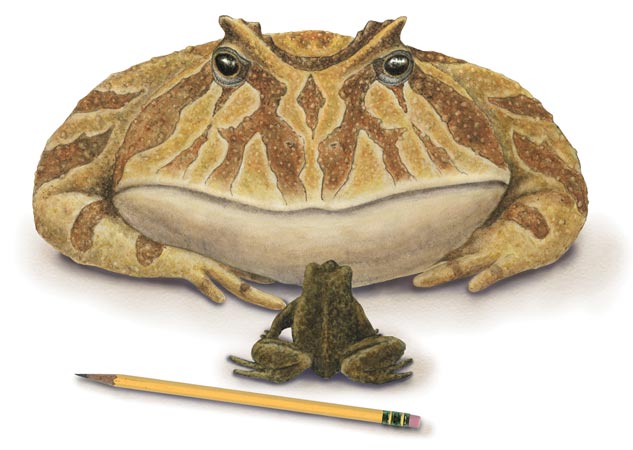Huge Frog Was Eating Machine

With an armored head and a mammoth 16-inch body, it wasn't quite the frog prince. Scientists have discovered the remains of what might have been the largest and fattest frog ever to have lived on Earth.
A team of researchers unearthed the fossilized frog in Madagascar. Dating from about 65 million to 70 million years ago during the Cretaceous Period, the frog is 3.5 inches longer than the largest living frog, the goliath frog of West Africa.
The scientists named the creature Beelzebufo ampinga, or "devil frog," because its incredible size, frightening appearance and predatory nature made them call it "the frog from hell," said Stony Brook University paleontologist David Krause, who led the team that discovered it.
Fierce predators
"They are just these big round blobs, basically all mouth and stomach," Krause told LiveScience. "They were sit-and-wait, ambush predators."
They didn't have very long legs, so they probably didn't hop around much. It was more likely they would let prey come to them. The scientists think they feasted on smaller frogs, lizards and mice.
"When you consider its size, I don't think it's outside the realm of possibility that it could have consumed some hatchling dinosaurs," Krause said. The largest living frog on Madagascar today, at just over 4 inches long, "would have been a nice hors d'oeuvre for Beelzebufo."
Get the world’s most fascinating discoveries delivered straight to your inbox.
The discovery will be reported on-line this week in the journal Proceedings of the National Academy of Sciences (PNAS).
Land bridge
Krause collaborated with frog experts Susan Evans, lead author of the PNAS article, and Marc Jones of the University College London, to find the ancient frog's closest living relatives. They were surprised to discover that Beelzebufo is very closely related to a family of modern frogs living in South America called Ceratophrys, or "pac-man" frogs, because of their huge mouths.
"The finding presents a real puzzle biogeographically, particularly because of the poor fossil record of frogs on southern continents," Krause said. "We're asking ourselves, ‘What's a South American frog doing half-way around the world, in Madagascar?'"
The discovery may provide direct evidence that Madagascar, the large island off Africa's southeast coast, was once linked by land to South America.
The frogs could not have swum between the two, because they rely on freshwater and can't live in saltwater. Scientists can't rule out the chance that they traveled across the ocean on some kind of float, "but it's sort of impossible to believe that they rafted from South America to Madagascar," Krouse said.
The researchers think there was probably a bridge between the two places, possibly the land that would become Africa or Antarctica. The trouble is, so far the frog fossils found in Africa are not closely linked to those found in either South America or Madagascar, and paleontologists have found very few frog fossils in Antarctica.
The scientists previously suspected a link between Madagascar and South America because they found closely related fossils of Cretaceous animals, including dinosaurs, in both places. The new discovery supports this hypothesis by providing the first evidence of a creature that once lived in Madagascar that has living relatives in South America.
- Top 10 Deadliest Animals
- Video: Under Antarctic Ice
- Image Gallery: Snakes, Frogs and Lizards



